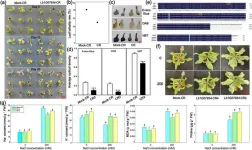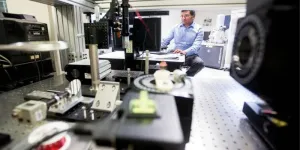(Press-News.org) Recent research has uncovered the genetic mechanisms behind sea lavender's (Limonium bicolor) salt tolerance by studying basic helix–loop–helix (bHLH) transcription factors. Identifying 187 bHLH genes, the study highlights their roles in salt gland development and stress responses. CRISPR-Cas9 validation demonstrated specific bHLH genes' critical role in enhancing salt tolerance, paving the way for future applications in crop improvement and saline soil management.
Basic helix–loop–helix (bHLH) transcription factors are essential for various plant processes, including growth, development, and stress responses. Sea lavender, a recretohalophyte with unique salt glands, exhibits high salt tolerance, making it an ideal model for studying salt resistance mechanisms. With soil salinization posing an increasing threat to global agriculture, understanding the genetic basis of salt tolerance is crucial. Given these challenges, exploring the bHLH gene family in Limonium bicolor could reveal valuable applications for enhancing crop resilience and improving saline soils.
Researchers from Shandong Normal University have made significant strides in understanding sea lavender's salt tolerance mechanisms, publishing their findings (DOI: 10.1093/hr/uhae036) in Horticulture Research on February 2, 2024. The study focuses on the genome-wide identification of bHLH transcription factors in sea lavender and their role in salt gland development. By analyzing the characteristics, localization, and phylogenetic relationships of 187 bHLH genes, the researchers uncovered their significant roles in regulating plant growth and stress responses.
The study identified 187 bHLH transcription factor genes in the Limonium bicolor genome, revealing their roles in plant growth, development, and stress responses. Bioinformatics analyses highlighted conserved bHLH domains and cis-regulatory elements linked to stress tolerance and epidermal structure development. Researchers focused on nine key bHLH genes, examining their localization and expression. CRISPR-Cas9 knockout and overexpression lines highlighted the critical role of Lb1G07934 in salt gland formation and salt resistance. Knockout lines showed enhanced salt tolerance and Na+ efflux, while overexpression lines exhibited reduced salt tolerance. These findings suggest a complex regulatory network and pave the way for future agricultural applications.
Dr. Baoshan Wang, a leading researcher in plant stress biology at Shandong Normal University, stated, "This study marks a significant advancement in our understanding of the genetic mechanisms behind salt tolerance in halophytes. The identification and functional analysis of bHLH genes in Limonium bicolor open new avenues for developing salt-tolerant crops, which is crucial for global food security amidst increasing soil salinization."
This research has profound implications: integrating sea lavender's salt tolerance into crops can enhance productivity on saline lands, boosting global food security and sustainable land use. The study's genomic analysis and genetic modification approach also pave the way for improving crop resilience to various stress factors.
###
References
DOI
10.1093/hr/uhae036
Original Source URL
https://doi.org/10.1093/hr/uhae036
Funding information
The National Natural Science Research Foundation of China (NSFC, projects 32370304 and 32170301) and the MOE Layout Foundation of Humanities and Social Sciences (21YJAZH108) supported this study.
About Horticulture Research
Horticulture Research is an open access journal of Nanjing Agricultural University and ranked number one in the Horticulture category of the Journal Citation Reports ™ from Clarivate, 2022. The journal is committed to publishing original research articles, reviews, perspectives, comments, correspondence articles and letters to the editor related to all major horticultural plants and disciplines, including biotechnology, breeding, cellular and molecular biology, evolution, genetics, inter-species interactions, physiology, and the origination and domestication of crops.
END
Unlocking salt resistance: sea lavender's genetic secret revealed
2024-06-05
ELSE PRESS RELEASES FROM THIS DATE:
Six UTA faculty receive prestigious CAREER grants
2024-06-05
Six faculty members from The University of Texas at Arlington received more than $3.23 million in awards as part of the National Science Foundation’s (NSF) Faculty Early Career Development Program. Called CAREER, these awards are considered the NSF’s most prestigious for early-career faculty and are given to those who have the potential to serve as academic role models in research and education.
Between 2017 and 2022, UTA received nine CAREER awards; in 2023, it received six. Vice President of research and innovation Kate C. Miller called this “a true testament to the world-class research teams we’re assembling here in Arlington.”
“CAREER ...
Brain overgrowth dictates autism severity, new research suggests
2024-06-05
Some children with autism experience profound, lifelong difficulties like developmental delay, social struggles and even the inability to speak. Others experience more mild symptoms that improve with time.
The disparity in outcomes has been a mystery to scientists, until now. A new study, published in Molecular Autism by researchers at University of California San Diego, is the first to shed light on the matter. Among its findings: The biological basis for these two subtypes of autism develops in utero.
Researchers ...
MD Anderson Research Highlights for June 5, 2024
2024-06-05
HOUSTON ― The University of Texas MD Anderson Cancer Center’s Research Highlights showcases the latest breakthroughs in cancer care, research and prevention. These advances are made possible through seamless collaboration between MD Anderson’s world-leading clinicians and scientists, bringing discoveries from the lab to the clinic and back.
Recent developments at MD Anderson offer insights into a lower-intensity therapy combination for older patients with acute myeloid leukemia (AML), a novel T cell therapy for patients with bone marrow failure syndromes, a proof-of-concept study using MRI to detect metabolic changes inside tumors, a molecular target to overcome treatment resistance ...
New study finds many of the world’s most threatened species lack evidence of sufficient conservation efforts
2024-06-05
-With images-
A new study has revealed alarming gaps in the implementation of conservation interventions for thousands of the world's most threatened species.
The research, published in the journal Nature, shows that most terrestrial plant and animal species at risk of extinction from threats like habitat loss, over-exploitation for trade, and invasive species are not receiving the appropriate types of conservation efforts needed to protect them.
The study findings suggest that there is a serious mismatch between the ...
BU study: Black-specific incarceration rates are associated with Black firearm homicide rates
2024-06-05
(Boston)—Firearm-related injury remains a significant burden in the U.S. with more than 45,000 people dying from these injuries in 2020. Suicides continue to account for the majority of all gun deaths. The number of homicides due to gun violence decreased between 1990 and 2010, but the last decade has seen an uptick. Homicides now make up 45% of all gun-related deaths, and Black and other minorities are overrepresented among firearm homicide victims. Moreover, there has been a stark increase in incarcerated populations in the U.S since the 1980s largely due to differential drug sentencing, ...
New technique reveals how gene transcription is coordinated in cells
2024-06-05
The human genome contains about 23,000 genes, but only a fraction of those genes are turned on inside a cell at any given time. The complex network of regulatory elements that controls gene expression includes regions of the genome called enhancers, which are often located far from the genes that they regulate.
This distance can make it difficult to map the complex interactions between genes and enhancers. To overcome that, MIT researchers have invented a new technique that allows them to observe the timing of gene and enhancer activation in a cell. When a gene is turned on around the same time as a particular enhancer, it strongly suggests the enhancer ...
Major cause of inflammatory bowel disease discovered
2024-06-05
Researchers at the Francis Crick Institute, working with UCL and Imperial College London, have discovered a new biological pathway that is a principal driver of inflammatory bowel disease (IBD) and related conditions, and which can be targeted using existing drugs.
About 5% of the world’s population, and one in ten people in the UK1, are currently affected by an autoimmune disease, such as IBD, the umbrella term for Crohn’s disease and ulcerative colitis. These diseases are also becoming more common, with over half a million people living with IBD in the UK as of 2022, nearly double the 300,000 previously estimated2.
Despite increasing prevalence, current treatments do not ...
Cooperative proteins help the immune system identify and attack invaders
2024-06-05
LA JOLLA (June 5, 2024)—Bacteria, parasites, viruses—the immune system tackles them all. At the front line of the human immune response are cells called macrophages, which are responsible for correctly identifying intruders and then directing how the entire immune system responds. Researchers at the Salk Institute have now discovered a molecular mechanism that helps macrophages mount a coordinated response tailored to a specific immune challenge.
Activating macrophages requires the work of three versions of a protein complex called SWI/SNF: cBAF, ncBAF, and PBAF. Scientists already knew these variants had slightly different structures, but ...
Why do 1 in 10 Americans get eczema? Is it too much salt?
2024-06-05
Why Do 1 in 10 Americans Get Eczema? Is it Too Much Salt?
UCSF Study finds that changes in daily salt intake may explain eczema flares.
A high sodium diet may increase the risk of eczema, according to researchers at UC San Francisco (UCSF), who found that eating just one extra gram of sodium per day – the amount in a Big Mac – increases the likelihood of flares by 22%.
Eczema, also known as atopic dermatitis, is a chronic disease that causes dry, itchy skin. It’s one of ...
Banning false information traffickers online improved public discourse
2024-06-05
When Twitter banned more than 70,000 traffickers of false information from its platform in the wake of the violence at the U.S. Capitol on Jan. 6, 2021, the impact went beyond the silencing of those users.
A study co-authored by UC Riverside public policy and political science scholars published in the journal Nature on Wednesday, June 5, found that the crackdown by Twitter (now called X after it was acquired by billionaire Elon Musk in late 2022) also significantly reduced the number of misinformation posts by users who stayed on the platform but had been following those who were kicked off.
Additionally, the study found that many of the misinformation ...





